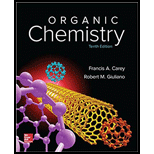
Concept explainers
Interpretation:
The synthesis of each of the given compound from the indicated starting material is to be stated.
Concept introduction:
The hydration of
The reagent
Lithium aluminum hydride and sodium borohydride are strong reducing agents. They are inorganic compounds and are used as the reducing agents in organic synthesis. They are used for the conversion of carboxylic acids, aldehydes and ketones into primary and secondary alcohols.
Answer to Problem 49P
Solution:
a) The synthesis of

b) The synthesis of

c) The synthesis of

d) The synthesis of

e) The synthesis of

f) The synthesis of

g) The synthesis of

h) The synthesis of

i) The synthesis of the desired compound from its starting material is shown below.

Explanation of Solution
a)
The preparation of

b)
In the preparation of

c)
In the preparation of
In the next step, further nitration takes place followed by the addition of

d)

In the first step of the reaction, the starting material reacts with
In the next step, the resulting compound reacts with

e)
The preparation of
In the next step, the resulting compound reacts with

f)
The preparation of

g)
In the synthesis of
In the final step, reduction of ketone occurs to yield the final product

h)

The preparation of
The synthesis of

i)

In this conversion, the formation of seven-membered ring present between two benzene rings occurs. Lithium aluminum hydride and sodium borohydride are strong reducing agents. The synthesis of the desired compound from its starting material is shown below.

Want to see more full solutions like this?
Chapter 22 Solutions
ORGANIC CHEMISTRY-W/STUD.SOLN.MAN.
- (a) Draw the structure of the following :(i) p-Methylbenzaldehyde (ii) 4-Methylpent-3-en-2-one(b) Give chemical tests to distinguish between the following pairs of compounds :(i) Benzoic acid and Ethyl benzoate, (ii) Benzaldehyde and Acetophenone.(iii) Phenol and Benzoic acid.arrow_forward(b) Propose a synthesis of (2,2-dimethylpropyl)benzene from benzene.arrow_forwardWrite structural formulas for the following compounds (includes both old- and new-style names).(a) 2-octyne (b) ethylisopentylacetylene (c) ethynylbenzene(d) cyclohexylacetylene (e) 5-methyl-3-octyne (f) trans-3,5-dibromocyclodecynearrow_forward
- Predict the products of the following acid-base reactions. If the equilibrium would not result in the formation of appreciable amounts of products, you should so indicate. In each case label the stronger acid, the stronger base, the weaker acid, and the weaker base: (a) CH3CH=CH2 + NANH2 (d) CH3C=C: + CH;CH2OH → (e) CH3C=C:- + NH¾CI – | (b) CH;C=CH + NaNH2 (c) CH3CH2CH3 + NANH2 → | HASarrow_forwardElectrophilic aromatic substitution usually occurs at the 1-position of naphthalene, also called the a position. Predict the major products of the reactions of naphthalene with the following reagents.(a) isobutylene and HF (b) cyclohexanol and BF3 (c) fuming sulfuric acidarrow_forward(i) State reagents G and J. (ii) Draw the structural formula for compounds D, E and H.arrow_forward
- Write the equilibrium-constant expressions and obtain numerical values for each constant in (a) the basic dissociation of aniline, C6H5NH2. (b) the acidic dissociation of hypochlorous acid, HClO. (c) the acidic dissociation of methyl ammonium hydrochloride, CH3NH3Cl. (d) the basic dissociation of NaNO2. (e) the dissociation of H3AsO3 to H3O+ and AsO33- just answer the letters C, D and E.arrow_forwardWrite the reagent or draw structures of the starting material or organic product(s) in the following reactions. If more than one product is formed, identify the major product where possible. (a) (b) HO OH OH H2SO4 ? Cl₂ ? FeCl3arrow_forwardSome of the most useful compounds for organic synthesisare Grignard reagents (general formula R-MgX, where X is ahalogen), which are made by combining an alkyl halide, R-X,with Mg. They are used to change the carbon skeleton of a start-ing carbonyl compound in a reaction similar to that with R-Li:.(a) What is the product, after a final step with water, of thereaction between ethanal and the Grignard reagent of bromo-benzene? (b) What is the product, after a final step with water, ofthe reaction between 2-butanone and the Grignard reagent of2-bromopropane? (c) There are often two (or more) combina-tions of Grignard reagent and carbonyl compound that will givethe same product. Choose another pair of reactants to give theproduct in (a). (d) What carbonyl compound must react with aGrignard reagent to yield a product with the -OH group at theendof the carbon chain? (e) What Grignard reagent and carbonylcompound would you use to prepare 2-methyl-2-butanol?arrow_forward
- (a) How will you convert:(i) Benzene to acetophenone (ii) Propanone to 2-Methylpropan-2-ol(b) Give reasons :(i) Electrophilic substitution in benzoic acid takes place at meta position.(ii) Carboxylic acids are higher boiling liquids than aldehydes, ketones and alcohols of comparable molecular masses.(iii) Propanal is more reactive than propanone in nucleophilic addition reactions.arrow_forward2) Provide acceptable names for the following structures: | CH,—С—NН— Ph Ph — О—С- CH;arrow_forwardDraw the organic product obtained by hydroboration-oxidation of each of the following alkenes: (a) trans-2-pentene, (b) 2-tert-butyl-3,3-dimethyl-1- butene, and (c) 1-methylcyclohexene. Having done this, draw the product of the acid-catalyzed hydration of these same alkenes. How do the reaction products differ?arrow_forward
 ChemistryChemistryISBN:9781305957404Author:Steven S. Zumdahl, Susan A. Zumdahl, Donald J. DeCostePublisher:Cengage Learning
ChemistryChemistryISBN:9781305957404Author:Steven S. Zumdahl, Susan A. Zumdahl, Donald J. DeCostePublisher:Cengage Learning ChemistryChemistryISBN:9781259911156Author:Raymond Chang Dr., Jason Overby ProfessorPublisher:McGraw-Hill Education
ChemistryChemistryISBN:9781259911156Author:Raymond Chang Dr., Jason Overby ProfessorPublisher:McGraw-Hill Education Principles of Instrumental AnalysisChemistryISBN:9781305577213Author:Douglas A. Skoog, F. James Holler, Stanley R. CrouchPublisher:Cengage Learning
Principles of Instrumental AnalysisChemistryISBN:9781305577213Author:Douglas A. Skoog, F. James Holler, Stanley R. CrouchPublisher:Cengage Learning Organic ChemistryChemistryISBN:9780078021558Author:Janice Gorzynski Smith Dr.Publisher:McGraw-Hill Education
Organic ChemistryChemistryISBN:9780078021558Author:Janice Gorzynski Smith Dr.Publisher:McGraw-Hill Education Chemistry: Principles and ReactionsChemistryISBN:9781305079373Author:William L. Masterton, Cecile N. HurleyPublisher:Cengage Learning
Chemistry: Principles and ReactionsChemistryISBN:9781305079373Author:William L. Masterton, Cecile N. HurleyPublisher:Cengage Learning Elementary Principles of Chemical Processes, Bind...ChemistryISBN:9781118431221Author:Richard M. Felder, Ronald W. Rousseau, Lisa G. BullardPublisher:WILEY
Elementary Principles of Chemical Processes, Bind...ChemistryISBN:9781118431221Author:Richard M. Felder, Ronald W. Rousseau, Lisa G. BullardPublisher:WILEY





